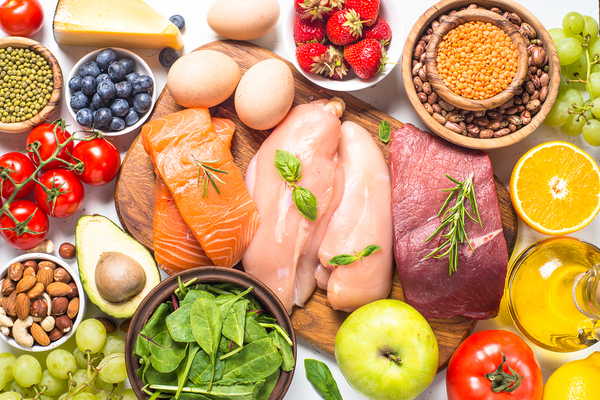


Nutritional ketosis is a healthy and natural metabolic state that occurs when the body utilizes fat and ketones as its primary fuel source. This switches your body from being a sugar-burning machine into a fat-burning machine.
Changing your eating habits can turn your body from a sugar-burning system to a fat-burning system.
Since the ketogenic diet is the #1 trendiest diet of 2018, this creates the impression that it's just another diet fad, that will come and go in time, but that is far from the case. The keto diet isn’t really a “diet”, but an eating strategy or protocol. It's actually an eating strategy that the human race depended on for millennia before industrialization, which spawned the beginning of the high carbohydrate diet we know as the Standard American Diet (SAD).
In fact, the human body is designed to function in a state of nutritional ketosis. Babies are born in a state of ketosis and mother's milk contains primarily fat, so breastfed babies are developing on a ketogenic diet.
It was actually Mother Nature that created the ketogenic diet. If we were not able to produce ketones and burn them for fuel, there's a very good chance that the human race would not have survived. Even today, indigenous cultures from the polar regions to equatorial regions consume traditional diets with macronutrient ratios that are remarkably similar to those recommended for nutritional ketosis. The common denominator among these varied cultures is consumption of high levels of fats (exclusive of man-made trans fats and other highly processed polyunsaturated oils) and minimal forms of carbohydrates.
Your blood cells and some cells in the brain and kidneys do require glucose to function properly. But you hardly have to consume any glucose to get it, because the body can generate carbohydrates through a process where non-carb substances like amino acids (gluconeogenesis) and parts of fatty acids are converted into glucose. With a ketogenic diet, your body gets enough carbohydrates from vegetables, low sugar fruits, nuts and seeds to create sufficient glucose for its needs.
The general guidelines for following a ketogenic diet are to consume 70-80% of your calories from healthy fats, 20-30% of your calories from protein, and only 5-10% of your calories from healthy, high-fiber sources of carbohydrates. It's important to consume sufficient fiber while on a ketogenic diet. It's necessary to avoid constipation and it functions as a fuel source for the healthy microbes in your gut.
The term net carbs (total carbs - fiber) is often used when discussing a ketogenic diet, for fiber does not get absorbed by the body. It passes through to the large intestine where it is gobbled up by your healthy gut bacteria. So, when following a ketogenic diet, it is important to consume a sufficient amount of high-fiber vegetables. Your net carb intake should fall between 20-40 grams.
The keto calculator at PerfectKeto is a great way to keep track of your net carbs and macros. It works by calculating your total energy expenditure. You input your height, weight, age, and sex. You factor in your weight loss and fitness goals, and the calculator will give you everything you need to create perfectly balanced meals every time. Input the number of meals you eat in a day, and information on your lifestyle and exercise regime for even more personalization options.

People notice many positive changes once their body transitions to nutritional ketosis. It can take several weeks for your body to make the transition from burning carbs for energy to burning fats for fuel. Some people experience 'carb withdrawal' or 'keto-flu' symptoms like headaches, dizziness and fatigue during this period, but these symptoms are temporary.
It’s important to make sure you stay hydrated with plenty of water during this time, and ensure that your ketogenic diet supplies sufficient vitamins and minerals. An easy method of adding vital electrolytes and minerals on a keto diet is to drop a pinch of Himalayan pink salt into your water a few times per day. It’s also important to remember that the transition period is temporary, and for most people, the discomfort will end up being well worth the positive results from sticking with the keto diet.
Once your body reaches a state of nutritional ketosis, you’ll find that you have far fewer cravings, and less hunger. At the same time, you will notice higher energy levels and greater mental clarity. Many people notice improvements in their skin quality and have an easier time maintaining muscle mass.
Furthermore, because of the low levels of carbohydrates in the ketogenic diet, blood sugar levels remain more consistent, for more predictable energy levels.
Research is even showing benefits to brain health as well as cardiovascular improvements from following a ketogenic diet. Even some board certified cardiologists are recommend this dietary protocol to their patients. The ketogenic diet is far different from the Standard American diet, but it is not a fad diet.
Rather, nutritional ketosis is the way the human body operated for thousands of years. We were metabolically flexible; naturally burning ketones when needed and glucose when it was available. And that should be our goal now, to retrain our bodies to do what it can do naturally to keep us energized, nourished and lean. If you’re interested in learning more about holistic nutrition and achieving nutritional ketosis, we encourage you to contact us at any time.